Muskie (Esox masquinongy) are a large species of freshwater fish that are native to North America. Muskie is just a nickname for this species of fish, the true name is muskellunge. In the pike family muskie are the largest member and they are actually a very uncommon fish. They are only found in large rivers, mesotrphic lakes and oligotrophic lakes in North America. Muskie will hunt and feed on prey that is up to 30% of its body length and this can include fish crayfish, frogs, ducklings, muskrats, mice snakes and other small birds or mammals. In the spring months they will prey on generally small prey while in the fall they will hunt larger prey to prepare for the winter months.
Contents
Where to Fish
New River
The lower New River in southwest Virginia and West Virginia is the best option for musky in the area. The state record musky was pulled out of these waters in 2007.
James River
The upper James River above Lynchburg is not quite a big a river as the New, but is rapidly gaining a reputation as a musky fishery of equal production.
Shenandoah River
The VDGIF stocks both forks and the main channel of the Shenandoah, adding an intimidating predator lurking just under the surface of one of the East’s most beautiful rivers.
Cave Run Lake
The “Musky Capital of the South” is located just east of Lexington, Ky. and is famous for its large fish and consistent feeding action. The 54-inch state record was caught here in 2008, but you can also fish the tailwaters.
Melton Hill Lake
Part of the Clinch River system in Tennessee, Melton Hill Lake is nearly 5,500 acres of prime predator habitat. The tailwaters are another great option, and a 50-inch limit is a testament to the behemoths that lurk there.
Equipment
First-and-foremost, know that musky fishing is not a cheap hobby (or addiction). The high prices of baits, rods, reels, line, etc. may steer many new musky anglers to buy the cheaper musky gear. Take my advice from someone who has “been there, done that”. It will be much cheaper in the long run to make the initial investment to buy quality gear. Outlined below are my recommendations and necessities for musky fishing.
Release Tools – Catch and release of every musky is critical in order to keep this sport alive. Having the correct, quality release tools should be the first thing any musky angler buys. ALWAYS CATCH AND RELEASE.
- High leverage bolt/ hook cutters
- Needle-nose pliers
- Musky-sized jaw spreader
- Mike Hulbert’s Musky Release gloves
- Muskie Bumper – 60” Fatboy Muskie Bumper
- Frabill 40” X 44” Power Catch “Big Kahunna” Net – A net of this size is used to as an “in-lake” live well. It’s important that you keep the musky in the net while unhooking it, taking it out of the water only briefly for a short picture.
Musky Fishing Baits
There are thousands of musky baits to choose from, ranging from small spoons to two pound soft plastic baits. If you are new to the musky fishing world, knowing where to start can be extremely difficult. This section of the article outlines what I consider “must-have baits” for the any musky angler. Every bait has a time and place for different times of the year and conditions.
The “Figure 8” – Quite possibly the most abstract concept to most new musky anglers, the “figure 8.” Muskies, being at the top of the food chain in most waters they inhabit, have little to nothing to fear. This makes them curious and meticulous by nature, which results in very abstract feeding habits. Muskies will often follow a potential meal before even considering actually eating it, your bait included. So, how do you coax a following musky into eating your bait? The figure 8. Think of a boat side figure 8 as an extension of your cast. As you’re reeling in your bait and it gets close to the boat, whether you see a fish behind it or not, start speeding up the retrieval speed. You never want to reel slower when going into the figure 8. Put your rod tip into the water and make wide sweeping “figure 8” motions with little (about 2 feet) line out. Wide turns are key to successful figure 8’s. It is very hard for a 48-inch musky to follow your bait if the arc lengths of your turns are only 30 inches. If a musky is following boat side and is right behind the bait, in-and-out of every turn and speed up your figure 8. Oppositely, if a following musky is very lethargic and seems uninterested, slow down your figure 8 in hopes that it will seem to be an easier target. Every cast, no matter what bait used, ends with a proper figure 8.






